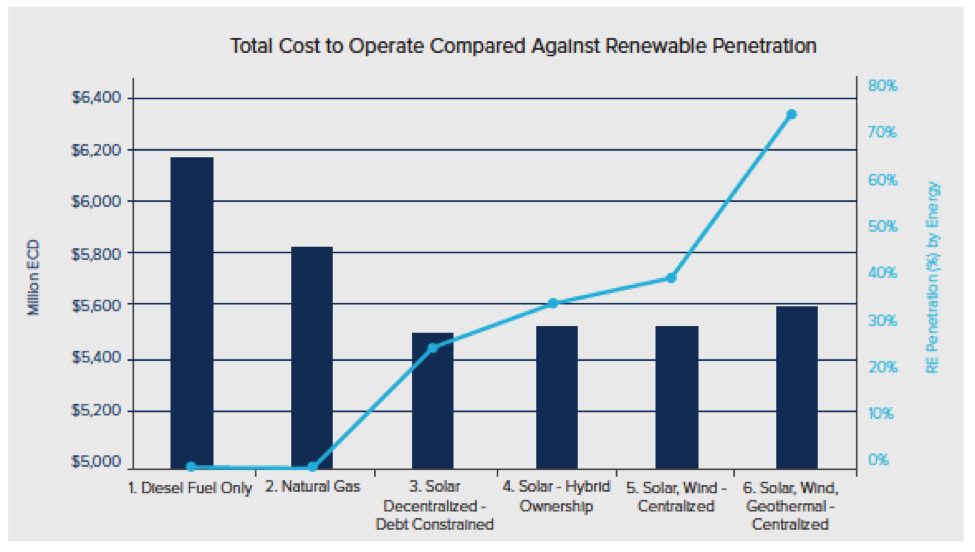
Saint Lucia’s Journey to a Renewable Future
In the southern Lesser Antilles lies the green, mountainous island of Saint Lucia, famous for the scenic Piton mountains and honeymooners. The island’s 180,000 residents and tourism-driven economy depend heavily on reliable electricity service. Today, that electricity is generated almost exclusively from imported diesel fuel, leaving Saint Lucia vulnerable to a costly and volatile energy source. At the same time, the island boasts strong renewable resource potential, including solar, wind, and geothermal. Developing these resources in a manner that preserves the natural environment, supports local employment, and ensures a reliable and cost-effective electricity system represents a challenge and an opportunity for leaders in Saint Lucia. Over the past year, these leaders seized the opportunity and decided to take on that challenge—starting with the region’s first national energy action plan developed jointly by the government and investor-owned utility, followed by a pioneering utility solar project that sets this model island nation on a pathway toward a sustainable energy transition.
A Sustainable Leader
Despite being a small island, Saint Lucia has a history of demonstrating outsized leadership on the global stage. At the 2015 United Nations Climate Change Conference in Paris, Saint Lucia, along with other small island developing states, spearheaded the effort to limit long-term global temperature increase to 1.5 C°. At home, Saint Lucia sought to continue that leadership by making deep reductions to the country’s emissions and demonstrating the viability of this global target. Moving away from an established electricity system toward a low-carbon future, however, requires a careful and long-term effort underpinned by the alignment of key stakeholders—most importantly the government and the utility. All too often, utilities and governments speak at cross-purposes. This adversarial relationship jeopardizes the collaboration required to achieve an integrated energy transition. Saint Lucia has chosen the path of cooperation, demonstrating regional leadership by committing to an open and inclusive process to determine its optimal energy pathway.
In 2016, the Government of Saint Lucia created the National Utilities Regulatory Commission (NURC) to oversee and regulate the electricity system in Saint Lucia. With the NURC established, the government and Saint Lucia Electricity Services Limited (LUCELEC) sought external support from Rocky Mountain Institute—often recognized as Rocky Mountain Institute-Carbon War Room (RMI-CWR)—and the Clinton Climate Initiative (CCI) to build an objective, fact-based approach to an energy transition that would inform energy policy and regulation. RMI-CWR and CCI have been supporting both parties since 2012.
The National Energy Transition Strategy
Last year, LUCELEC and the Government of Saint Lucia together developed the National Energy Transition Strategy (NETS). The NETS is an energy transition action plan informed by independent, technical analysis that paves the road for a sustainable, reliable, cost-effective, and equitable electricity sector using the island’s local resources. This process, independent of any particular technology, yielded a detailed 20-year strategy as well as a suite of optimal near-term projects.
The NETS findings indicate that a portfolio of utility-owned solar, distributed solar, wind, and diesel together with energy storage offers the best economics for Saint Lucia. The realization of the least-cost energy mix offers a future where customers receive 10 percent rate relief within 20 years and electricity price volatility is stabilized—while maintaining a secure, financially viable position for LUCELEC in coming decades. The cost-effective long-term portfolios examined include:
- A combination of utility-scale and distributed solar (approximately 20 megawatts [MW] over the next eight years, with between 2 and 35 percent of the total being distributed);
- Utility-scale wind (starting with a 12 MW project with an additional project in the future);
- Energy storage to ensure reliability and integrate renewables;
- An energy efficiency program targeting lighting, refrigeration, air-conditioning, and water heating (to save 0.5 percent per year, growing to 11 percent of annual sales by 2024); and
- Existing diesel generators for flexibility (with no need to replace three diesel generators slated for retirement by 2019).
The approach outlined above offers the least-cost portfolio, and achieves approximately 40 percent renewable energy penetration. Adding a geothermal plant of 30 MW presents savings compared to the continued use of diesel fuel, and offers the potential to reach over 75 percent renewable energy penetration by 2025. Due to the falling prices of these technologies, the NETS recommends LUCELEC pursue solar and storage in its five-year plan, regardless of the outcome of geothermal exploration.
A Pioneering Solar Farm
Translating the NETS into action, LUCELEC recently signed a contract to begin construction of Saint Lucia’s first utility-scale solar farm, a 3 MW facility located near the Hewanorra International Airport in the south of the island. As the first generation asset outside of the main diesel plant at Cul de Sac, this new project begins to mitigate natural disaster and security risks from centralized generation at one location, making the electricity system more resilient against single points of failure. The procurement process, supported by RMI-CWR and CCI, occurred largely in parallel with the NETS process. Vetted bids from local and international firms confirmed the NETS-predicted costs and corresponded with the timelines of solar construction in Saint Lucia. This initial project supports the technical analysis with real-world inputs to demonstrate the viability of solar electricity generation on the island.
RMI-CWR and CCI along with the support of the Government of Saint Lucia initiated the project development in late 2014. Energy advisory firm DNV GL was brought on to conduct grid interconnection studies and to develop the tender documents and technical specifications for the solar farm, key aspects to de-risking the project before going to market. LUCELEC and the RMI-CWR and CCI team agreed on the use of international, open procurement to access experienced solar engineering, procurement, and construction firms while maintaining a competitive process to ensure low costs and high-quality bid submissions.
The process, however, was not without its challenges. In the midst of the solar project development process, the team faced geotechnical uncertainties, unexpected air traffic safety requirements for glint and glare, and difficulties surrounding planning approval as the first solar farm on the island. All of these challenges point to the difficulties of projects with no precedents or established procedures. LUCELEC’s and the government’s Renewable Energy Division’s commitment to overcome these challenges—with support from RMI-CWR and CCI—galvanized the 3 MW solar farm as a true joint effort. The lessons learned will add to the local knowledge base as well as help produce a more streamlined process for future renewable energy projects developed on the island.
Lowering Costs, Creating Jobs
The competitive process resulted in a nominal levelized cost of electricity for solar below 10.5 U.S. cents/kWh, falling below the cost of diesel generation—even with historically low oil prices in 2016. The 3 MW solar farm also fulfills the objectives of the NETS by advancing implementation of projects benefitting the country—including the opportunity to create new jobs in the clean energy sector. LUCELEC required that labor used for construction be 80 percent local, and that training be provided for LUCELEC’s staff during the operations and maintenance period following the installation. Both of these are key to building local skills in the solar energy industry.
As the first project commensurate with the plan outlined by the NETS, the 3 MW solar farm paves the way for the next set of projects—solar and storage, wind, or others—that interact with and demonstrate the viability of the NETS process. While energy road maps have been done before, few exercise a joint approach by deeply involved government and utility stakeholders, and most lack specific on-the-ground projects to pursue as outcomes of the study. Saint Lucia’s leadership in pursuing the NETS and the subsequent 3 MW solar farm solidify the island nation’s position as a leader in the region and a model for other small island developing states that face similar challenges and opportunities in pursuing a sustainable energy transition.
View the Case Study on Developing the Saint Lucia Energy Roadmap for insights about the NETS process, methodology, and select results.
Stephen Mushegan is a Senior Program Manager with Clinton Climate Initiative’s Islands Energy Program, focused on assisting Caribbean government and utility partners in de-risking and developing renewable energy projects. In this role, he worked with LUCELEC to oversee the development, procurement, evaluation, and contract negotiations for the 3 MW solar farm in Saint Lucia.
RMI-CWR’s Islands Energy Program is made possible by the support of the Global Environment Facility in partnership with the United Nations Development Program. CCI’s work is supported through government aid funding from Norway.
